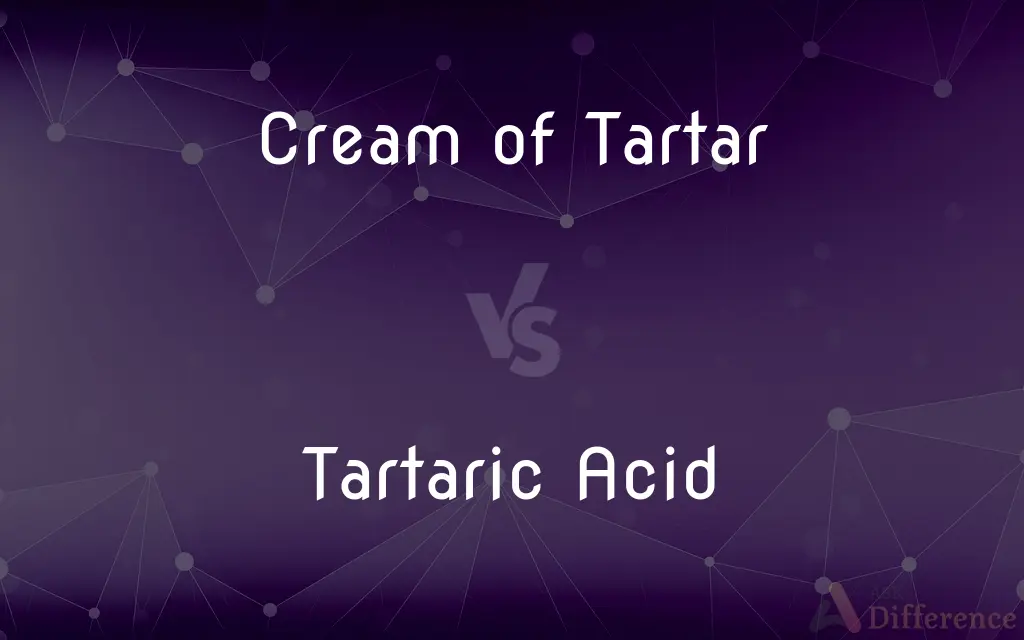Cream of Tartar vs. Tartaric Acid — What's the Difference?
By Tayyaba Rehman — Published on October 26, 2023
Cream of tartar, a white powder, is used in cooking and baking for its stabilizing properties, while tartaric acid, its acidic source, is used broadly in various industries for its acidic properties.

Difference Between Cream of Tartar and Tartaric Acid
Table of Contents
ADVERTISEMENT
Key Differences
Cream of tartar and tartaric acid, though closely related, hold distinct roles in cooking and other applications. Cream of tartar, scientifically known as potassium bitartrate, is a byproduct of winemaking and is often utilized to stabilize egg whites and creams as well as prevent sugar crystals from forming in syrups. On the other hand, tartaric acid, a naturally occurring organic acid found in various plants, is used not only in food and beverages to provide a sour taste but also in the production of cream of tartar.
In the culinary world, cream of tartar is a familiar name, specifically in the baking sector, where its ability to prevent sugar from crystallizing and stabilize whipped egg whites is particularly prized. The powder is notably used in snickerdoodle cookies to provide the signature tang. In contrast, tartaric acid, with its stronger, more direct acidic properties, can be used to control the pH of fermenting liquids during winemaking and has applications in the pharmaceutical and metal industries, reflecting a broader, more industrial application compared to cream of tartar.
While cream of tartar is largely known for its role in the kitchen, tartaric acid, due to its wider applicability, sees more varied use in technical contexts. Cream of tartar is often employed in baked goods, candies, and certain cooked sugars, enhancing texture and integrity, whereas tartaric acid might be used to regulate acidity and assist gelling in certain gel-like products and is often a component in baking powder.
In a nutshell, the application of cream of tartar is predominantly observed in the culinary world, primarily in baking and candy making, attributed to its stabilizing and anti-crystallizing features. Conversely, tartaric acid, due to its straightforward acidic properties, is present in various industries, including but not limited to, food, pharmaceutical, and industrial, making it a versatile compound in both a commercial and domestic context.
Comparison Chart
Use in Baking
Widely used to stabilize egg whites
Not commonly used due to its strong acidity
ADVERTISEMENT
Acidity Level
Mildly acidic
Strongly acidic
Physical Form
Often found as a white powder
Found as a white crystalline powder
Culinary Application
Mostly in baking and candy making
Limited, but used in some candies and beverages
Industrial Application
Limited to culinary uses
Extensively used in various industries including winemaking
Compare with Definitions
Cream of Tartar
A leavening agent when combined with baking soda.
The recipe calls for both baking soda and cream of tartar to help the cookies rise.
Tartaric Acid
An organic acid found in various plants.
Grapes contain a notable amount of tartaric acid.
Cream of Tartar
An ingredient used to produce a creamy texture in icings.
Cream of tartar gives the royal icing a smooth, glossy finish.
Tartaric Acid
A souring agent in food and beverages.
Tartaric acid provides a sour note to some candies and soft drinks.
Cream of Tartar
A component in baking powder.
Cream of tartar, when combined with baking soda, forms baking powder.
Tartaric Acid
A stabilizing agent in certain drug formulations.
Tartaric acid is used to stabilize the pH in some pharmaceuticals.
Cream of Tartar
A stabilizer in cooking, especially in candy making.
Cream of tartar prevents sugar from crystallizing in the syrup.
Tartaric Acid
A component in some cream of tartar formulations.
Tartaric acid is utilized in the production of cream of tartar.
Cream of Tartar
A helpful agent in stabilizing whipped egg whites.
Add a pinch of cream of tartar to keep your egg whites fluffy.
Tartaric Acid
An acidulant in the winemaking process.
Tartaric acid helps control the pH of wine, ensuring stability.
Common Curiosities
Is cream of tartar the same as baking powder?
No, but it is a component of baking powder, often combined with baking soda.
Can cream of tartar be replaced in recipes?
Yes, common substitutes include lemon juice and white vinegar, though the exact replacement ratio may vary.
Can cream of tartar spoil or expire?
Cream of tartar has an indefinite shelf life if stored properly, though it can clump over time.
What is cream of tartar?
Cream of tartar is a white, powdery acid (potassium bitartrate) often used in baking, notably in stabilizing whipped egg whites.
How is cream of tartar used in cooking?
It is used to stabilize meringues, prevent sugar crystallization, and act as a leavening agent when combined with baking soda.
Can tartaric acid be used in winemaking?
Yes, tartaric acid is essential in winemaking, helping to control the wine’s pH and enhance its stability and taste.
Why would I choose cream of tartar over tartaric acid, or vice versa?
Choice between the two depends on the application: cream of tartar is often used in baking for its stabilizing properties, while tartaric acid is selected for pH control and in certain specific culinary and non-culinary applications.
What is tartaric acid?
Tartaric acid is a naturally occurring organic acid found in plants like grapes and is used in various culinary and industrial applications.
Are cream of tartar and tartaric acid interchangeable?
Not always, as while they are chemically related, they have different properties and applications in cooking.
Can tartaric acid be substituted in recipes?
Yes, possible substitutes include citric acid and lemon juice, but they may alter the recipe's flavor profile.
Can both cream of tartar and tartaric acid be found in supermarkets?
Cream of tartar is commonly found in supermarkets, while tartaric acid might be available in specialized stores or online due to its more specialized applications.
Is tartaric acid safe to consume?
Yes, in the amounts typically used in food preparation, tartaric acid is generally recognized as safe.
Can I make my own cream of tartar using tartaric acid?
Not easily at home, as cream of tartar is derived from tartaric acid through a process that creates a milder, stabilized product.
How should cream of tartar and tartaric acid be stored?
Both should be stored in a cool, dry place, in a well-sealed container to prevent them from absorbing moisture from the air.
How is tartaric acid used in food preparation?
Tartaric acid is used to control the pH of foods, stabilize cream, and prevent discoloration of vegetables during cooking.
Share Your Discovery

Previous Comparison
Unitary Government vs. Federal Government
Next Comparison
Notes Receivable vs. Accounts ReceivableAuthor Spotlight
Written by
Tayyaba RehmanTayyaba Rehman is a distinguished writer, currently serving as a primary contributor to askdifference.com. As a researcher in semantics and etymology, Tayyaba's passion for the complexity of languages and their distinctions has found a perfect home on the platform. Tayyaba delves into the intricacies of language, distinguishing between commonly confused words and phrases, thereby providing clarity for readers worldwide.













































